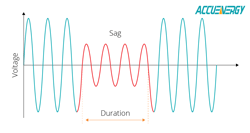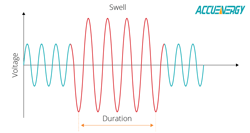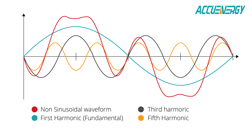Although industrial electricity customers may be mostly concerned with the amount of energy they are consuming, there’s a secondary issue that also requires attention: power quality.
In simple terms, power quality is the measure of how well the voltage, frequency, and waveform of a power supply conforms to established parameters. Facilities monitor power quality because deviations from a normal, sinusoidal waveform can have a direct impact on the performance of industrial, and especially electronic, equipment and can have serious consequences if left unchecked.
It’s important to note that minor fluctuations within determined limits are ordinary and may either go undetected or not have a negative impact. Some equipment within a facility may continue to operate normally, even with small fluctuations. However, facilities that rely heavily on microprocessor-based equipment may be at increased risk to even minor power quality issues which can cause noticeable disruptions such as unexpected resets or even electronic component failures. Process control equipment may also experience nuisance tripping, causing frustrating interruptions to ongoing operations.
Using a power quality meter to perform continuous monitoring of power quality within a facility may uncover one or more common PQ issues. Following is a brief description and the consequences of four, common issues.
| PQ Issue | Description/Cause | Consequences | What it Looks Like |
| Voltage Sag/Dip | A sag or dip is a 10% to 90% decrease in voltage that lasts from a few milliseconds (half a cycle) up to 60 seconds. It can be caused by motors starting up or shutting down, undersized circuits, or short circuits. | Microprocessor-based equipment (like computers or PLCs) can malfunction due to volage sags. Contactors or relays may trip and machienery used in processing operations may lose efficiency or stop functioning. Dips can also cause momentary dimming of lights or HMI display issues. |  |
| Voltage Swell | A voltage swell is the opposite of a sag/dip and is a short increase in the voltage above normal tolerances, typically at 110% or above. They can be caused by incorrectly sized power sources, start-up or shut down of large loads, or a fault on one phase of a three-phase system. | Like sags, votlage swells can cause equipment shutdowns and failures. Variable frequency drives (VFDs) may stop functioning while lighting and computer displays may flicker. PCs, PLCs, and other microprocessor-based equipment may lose data. |  |
| Transients | Also known as a spike and similar to a swell, a transient is a condition that lasts a split second (1/60th of a second or less) where the voltage is higher than expected. Lightening or static discharge are common causes of transients, but they can also be the result of disconnecting heavy loads. | Transients can be extremely damaging to any electronic equipment with a power supply, such as computers or instrumentation. High-tech manufacturing facilities, such as chip or memory producers, may be severely impacted as transients can destroy circuit boards and processors, bringing production to a halt. |  |
| Harmonic Distortion | Harmonic distortion is a deviation from or deformity of a normal, sinusoidal waveform, or sine wave. Sometimes called “dirty” or “noisy” electricity, it can be introduced by any non-linear load within a facility, such as LED lighting, DC power supplies, VFDs, welding machines, and more. Unlike transients or sags, harmonics can remain at a steady state. | High harmonic distortion can cause multiple problems including overheating of equipment like motors or wiring, reduced efficiency of machines, and nuisance tripping. Over time, harmonics can shorten the lifespan of equipment and reduce power capacity. Ultimately, the damage to equipment can be costly and cause unplanned shutdowns. |  |
 X
X 
 X
X  X
X  X
X